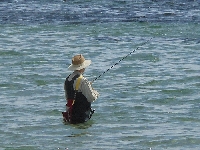
Figure out what do you wear for fishing when you are reeling in the big one
The days are long and meandering, paradise enveloping you. As you sit amidst the gently lapping waves, life’s stresses melt away and it’s just you, the rod, and a stunning horizon of pure bliss. A bite, a small tug, and it’s time to get to work.
The art of fishing can be relaxing, enjoyable, and reinvigorating for the soul. But, without the proper attire, that relaxation and bliss can turn into something else: an uncomfortable and sometimes hazardous experience.
Below, let’s take a look at what to wear for fishing in any temperature and climate. From fishing shorts and shirts to boots to safety gear, we’ll tell you everything you’ll need for that next great vacation away from life’s little stresses.
How to Prepare for Your Trip
Check the weather forecast. If it’s rainy, sunny, or a wintry mix, plan accordingly. How about a monster storm headed directly over your favorite fishing spot? Well, maybe plan a family outing somewhere else: like indoors. Now, that you have the weather report, what should actually wear?
~
How to Fish in Warm Weather
Despite the fact that the dog days of Summer will most likely be sizzling, it’s important to note that most fisherman head out early in the morning (when it’s still somewhat chilly) and finish late in the evening (when it’s becoming cooler as the sun sets). So, even in warm weather, it’s pertinent to bring a sweater, jacket, or other such insulated gear in order to cover all your bases.
Remember sunblock (and insect repellent, depending on where you are in the country) and try to find clothing which will protect you from the sun’s harmful rays. Western-style hats can be a good starting point, as they’ll reduce glare and limit sun exposure, too.
Even a baseball cap and sunglasses can do the job; find a lightweight and lightly colored cap in order to protect against the sun and keep yourself cool. In areas like Florida, the Gulf Coast, or other tropical, humid, and hot locales around the country, many experienced fishermen will place a cloth/rag/towel on the back of their caps. This way, they protect themselves from sun on the back of their necks.
For shoes, high-top sneakers or specialized boots can assist you in keeping your feet safe when standing on the bank or wading in shallow water. A pair of long, lightweight pants can assist in warding off sea nettles or jellyfish in salt water; in freshwater, long pants can help to limit damage from both rocks and snags, as well. For boat travel, look for shoes/boots which will assist you in not slipping or sliding on the wet surface.
And in any weather, it’s always important to think safety first. Always wear a life jacket, carry a cell phone (in a waterproof baggie/container), and travel with a group, if possible. For more safety information, head to TakeMeFishing.org. There, you’ll find information on first aid, tips for a safe trip, and much more.
How to Fish in Cold Weather
In winter — and in a variety of sub-zero locales around the country — fishing takes on a whole new meaning. So, what should you wear for fishing in these extreme circumstances? Well, to put it simply: layer. A fleece or wool cap can be a good starter option for anglers. Cover your head, ears, and, if possible, neck, as well.
Underwear should allow sweat to be wicked away from your body, thus keeping your body warm instead of creating a layer of sweat which can cool you down in already frigid temperatures. Look for wool-based products and newer synthetic clothing; skip cotton as it will become wet easily and take a long time to dry. Long underwear can be a top option for increased warmth.
Gloves can work as well but tend to make the act of casting and reeling in slightly more ungainly. Look for lightweight rubber gloves and hunter/fisherman’s gloves (which contain a flap that exposes part of the fingers). Try hand warmers and a personal floatation device for more warmth (and safety).
For shirts and pants, look for wool-based products that allow your body to breathe and moisture to escape. A jacket, coat, vest, or rain parka can be worn on top for more warmth. In addition, it’s important to protect one’s eyes during boat travel. Ski goggles will protect against freezing and debris, according to Bass Resource. Head over to their site to learn more about hypothermia conditions and treatment.
Finally: don’t fish on ice unless it’s more than four inches thick. Take Me Fishing feels that it should even be thicker than that for the proper amount of safety. And with that, no matter the temperature, locale, or weather conditions, you’ll be set for a cool, calm, and refreshing day on the water.
Resources:
Bass Resources: Preparing for Cold Weather.
Take Me Fishing: Fishing in Warm Weather.
Above photo attributed to mikecogh

